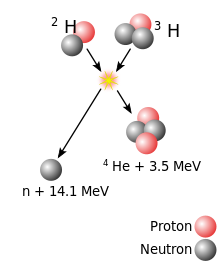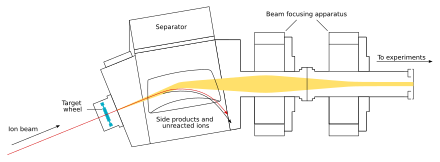Dubnium
The Soviet Joint Institute for Nuclear Research (JINR) claimed the first discovery of the element in 1968, followed by the American Lawrence Berkeley Laboratory in 1970.
The long-standing dispute was resolved in 1993 by an official investigation of the discovery claims by the Transfermium Working Group, formed by the International Union of Pure and Applied Chemistry and the International Union of Pure and Applied Physics, resulting in credit for the discovery being officially shared between both teams.
Theoretical research establishes dubnium as a member of group 5 in the 6d series of transition metals, placing it under vanadium, niobium, and tantalum.
Dubnium should share most properties, such as its valence electron configuration and having a dominant +5 oxidation state, with the other group 5 elements, with a few anomalies due to relativistic effects.
[25] The definition by the IUPAC/IUPAP Joint Working Party (JWP) states that a chemical element can only be recognized as discovered if a nucleus of it has not decayed within 10−14 seconds.
[59] The first report of the discovery of element 105 came from the Joint Institute for Nuclear Research (JINR) in Dubna, Moscow Oblast, Soviet Union, in April 1968.
[61] This report included an initial chemical examination: the thermal gradient version of the gas-chromatography method was applied to demonstrate that the chloride of what had formed from the SF activity nearly matched that of niobium pentachloride, rather than hafnium tetrachloride.
[61] In June 1970, JINR made improvements on their first experiment, using a purer target and reducing the intensity of transfer reactions by installing a collimator before the catcher.
[62] After collecting more data, JINR proposed the name bohrium (Bo) in honor of the Danish nuclear physicist Niels Bohr, a founder of the theories of atomic structure and quantum theory;[63] they soon changed their proposal to nielsbohrium (Ns) to avoid confusion with boron.
[69] Neither team showed interest in resolving the conflict through a third party, so the leading scientists of LBL—Albert Ghiorso and Glenn Seaborg—traveled to Dubna in 1975 and met with the leading scientists of JINR—Georgy Flerov, Yuri Oganessian, and others—to try to resolve the conflict internally and render the neutral joint group unnecessary; after two hours of discussions, this failed.
[71] In 1981, the Gesellschaft für Schwerionenforschung (GSI; Society for Heavy Ion Research) in Darmstadt, Hesse, West Germany, claimed synthesis of element 107; their report came out five years after the first report from JINR but with greater precision, making a more solid claim on discovery.
[69] In 1985, the International Union of Pure and Applied Chemistry (IUPAC) and the International Union of Pure and Applied Physics (IUPAP) formed a Transfermium Working Group (TWG) to assess discoveries and establish final names for the controversial elements.
[61] The party held meetings with delegates from the three competing institutes; in 1990, they established criteria on recognition of an element, and in 1991, they finished the work on assessing discoveries and disbanded.
[73] In 1995, IUPAC abandoned the controversial rule and established a committee of national representatives aimed at finding a compromise.
[75] In 1996, IUPAC held another meeting, reconsidered all names in hand, and accepted another set of recommendations; it was approved and published in 1997.
[79][80][81][82] However, the problem was resolved in the literature as Jens Volker Kratz, editor of Radiochimica Acta, refused to accept papers not using the 1997 IUPAC nomenclature.
[88] Elements with a lower atomic number have stable isotopes with a lower neutron–proton ratio than those with higher atomic number, meaning that the target and beam nuclei that could be employed to create the superheavy element have fewer neutrons than needed to form these most stable isotopes.
As of 2022, following additional experiments performed at the JINR's Superheavy Element Factory (which started operations in 2019), the half-life of 268Db is measured to be 16+6−4 hours.
[12] The second most stable isotope, 270Db, has been produced in even smaller quantities: three atoms in total, with lifetimes of 33.4 h,[91] 1.3 h, and 1.6 h.[92] These two are the heaviest isotopes of dubnium to date, and both were produced as a result of decay of the heavier nuclei 288Mc and 294Ts rather than directly, because the experiments that yielded them were originally designed in Dubna for 48Ca beams.
Significant deviations may nevertheless occur, due to relativistic effects,[o] which dramatically change physical properties on both atomic and macroscopic scales.
[3] Atoms of dubnium in the solid state should arrange themselves in a body-centered cubic configuration, like the previous group 5 elements.
Multiple authors[3] have researched dubnium pentachloride; calculations show it to be consistent with the periodic laws by exhibiting the properties of a compound of a group 5 element.
The tendency towards hydrolysis of cations with the highest oxidation state should continue to decrease within group 5 but is still expected to be quite rapid.
Surprisingly, the behavior on extraction from mixed nitric and hydrofluoric acid solution into methyl isobutyl ketone differed between dubnium, tantalum, and niobium.
Dubnium showed behavior different from that of tantalum but similar to that of niobium and its pseudohomolog protactinium at concentrations of hydrogen chloride below 12 moles per liter.
Later experiments in 1996 showed that group 5 chlorides were more volatile than the corresponding bromides, with the exception of tantalum, presumably due to formation of TaOCl3.
[3] In 2004–05, researchers from Dubna and Livermore identified a new dubnium isotope, 268Db, as a fivefold alpha decay product of the newly created element 115.
In the 2004 experiment, a thin layer with dubnium was removed from the surface of the target and dissolved in aqua regia with tracers and a lanthanum carrier, from which various +3, +4, and +5 species were precipitated on adding ammonium hydroxide.
The precipitate was washed and dissolved in hydrochloric acid, where it converted to nitrate form and was then dried on a film and counted.
[96] In 2021, the volatile heavy group 5 oxychlorides MOCl3 (M = Nb, Ta, Db) were experimentally studied at the JAEA tandem accelerator.






